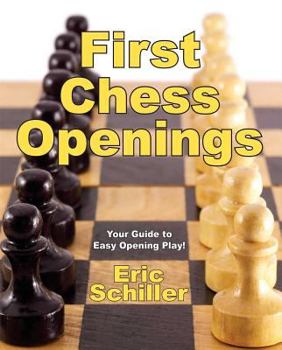First Chess Openings
Select Format
Select Condition 
Book Overview
A beginner's guide for children and newcomers to chess. TAKE YOUR FIRST STEP IN CHESS "First Chess Openings" teaches you solid, near-foolproof openings that will help you win. You'll learn the most... This description may be from another edition of this product.
Format:Paperback
Language:English
ISBN:1580421520
ISBN13:9781580421522
Release Date:June 2005
Publisher:Cardoza Publishing
Length:128 Pages
Weight:0.70 lbs.
Dimensions:0.5" x 7.6" x 9.2"
Customer Reviews
3 ratings
Loved it!
Published by Thriftbooks.com User , 15 years ago
I took a chance and bought this book, SO glad I did. Opening Study seems overwhelming to an amatuer player like myself. I pick up books on the Sicilian for example, and think "who am I kidding, I will never learn this??" This book, actually helped me, and helped a lot. With one Saturday afternoon, this book, and my chess board, I can play my computer and go a half dozen moves into various openings and defenses. Am I an expert at the Najdorf Sicilian? No, but I am a lot better off than I was, I now grasp how the Modern Defense can transition into other openings, etc. My computer normally responds (as black) with the French Defense, Caro-Kann, or the Sicilian. I now actually recognize those systems, have a gameplan, and further study will make me stronger. All this for $13? I'd say that's a GREAT bargain.
Exactly what it says
Published by Thriftbooks.com User , 17 years ago
An excellent introduction to the most important parts of opening theory with some ideas to give you a fun, open game. It has some rewarding tricks and traps, but is mostly designed to show you step by step how to make the most from the opening without mindless memorization. The section on closed games is very thin, but since most elementary games do not feature Queens Gambit or English Opening, this is little to fear. Most importantly, in his usual style, Schiller spends his time explaining the WHY of the moves, not just lists of analysis. I heartily recommend this volume as a way to get an opening repertoire for elementary or beginning players. Later, you will need to add other books to round out your game, especially for Queen's pawn openings. (For this I like Complete Defense To Queen Pawn Openings (Cardoza Publishing's Essential Opening Repertoire Series).) First Openings will give you enough opening knowledge to prevent frustration long enough to focus on tactics and endgame.
A good but slightly unbalanced approach
Published by Thriftbooks.com User , 19 years ago
In the search for the holy grail of a low-ranking player's opening repertoire I've gone through quite a few books, keeping in mind that low-rankers such as I should spend the great bulk of study time on tactics, not openings. So what is needed is something to get through the opening and into the middle game with at least rough equality; and this has to be done without learning countless variations and endless theory, most of which the lower class player is unlikely to encounter in any event. Schiller attempts to provide just this sort of thing, and succeeds at least to some degree. The book starts with the obligatory material on chess notation (which surely you know by now, or this book is not for you at all) and continues with about 18 pages on basic opening principles. The book continues with 60 pages on "Your White Openings," about 50 more on "Your Black Openings," and concludes with 10 pages on "Closed Games." Recommended for White is e4 and the Bishop's Opening (Bc4) in response to e5. How to play against other major lines, such as the Sicilian, French, etc., is covered as well. Schiller emphasizes concepts rather than lines and variations, which at the target skill level seems like the right thing. The criticism of not enough depth might apply, but unfairly, as that is not the purpose here. Schiller uses up quite a bit of space on the Fried Liver Attack (and more space later on its defense). While interesting and fun, these pages could have been better used on Closed Games, as I'll discuss below. To defend against e4 Schiller recommends e5 and takes us on a survey tour of where the game might go from there. He asks us not to be afraid of the Ruy Lopez and recommends the relatively unusual Cozio Defense. He explains the concepts quite well; you'll have to decide if this variant is to your taste. Schiller really skimps when, in the final chapter, he gets around to defending against 1 d4. His comment that you won't see the opening very often doesn't quite ring true enough. He takes us through one possible defense and leaves it at that. There is *no* discussion of any other White opening such as the English, Bird's etc. etc. The book starts out strong and seems to fade little by little, almost as if the author ran out of energy, or more likely, allowable page count. So, should you use this book? I think it provides many valuable insights and a reasonable plan for the lower class player, but even with its goal of presenting ideas, it lacks completeness. That said, it is probably one of the best books of its type. After all, the challenge of the almost self-contradictory concept of a "simplified beginner's opening repertoire" is considerable.






